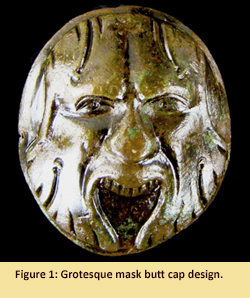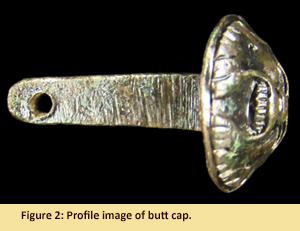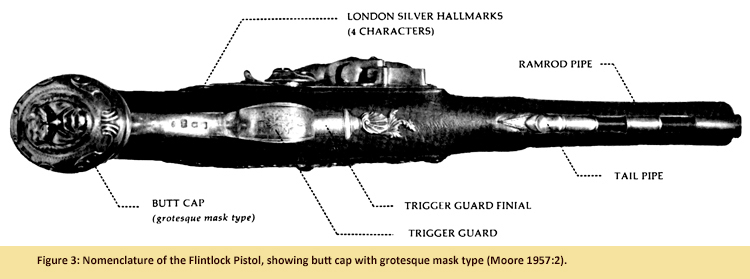Flintlock Pistol's Grotesque Butt Cap
November 2010
By Kelly Cooper, JPPM Education Coordinator
 During the summer of 2008, archaeologists working along the Potomac River in Charles County, Maryland excavated the remains of a brick foundation and cellar hole at the Bateman Site (18CH354), which dated approximately between 1730-1760. Based on historical documentation, the Bateman Site was originally part of a larger parcel of land known as Wollaston Manor, a 2,000-acre tract of land granted to Captain James Neale in 1642 by Lord Baltimore. Based on a building contract in 1660, Captain Neale and his family had a manor house constructed on this property the following year. Upon his death in 1684, Neale bequeathed to his eldest son James the portion of the Estate including the manor house. Family genealogy follows suit until the death of the fourth James Neale in 1730. By mid-eighteenth century, it is unclear as to who was living on this property. A 1755 subdivision plat of the Estate of Raphael Neale identified a one-and-a-half story house in the general vicinity of Site 18CH354. Regardless of ownership, artifacts recovered from the cellar hole at Site 18CH354 are important to help interpret colonial ideological change and continuity through the eve of Revolution.
During the summer of 2008, archaeologists working along the Potomac River in Charles County, Maryland excavated the remains of a brick foundation and cellar hole at the Bateman Site (18CH354), which dated approximately between 1730-1760. Based on historical documentation, the Bateman Site was originally part of a larger parcel of land known as Wollaston Manor, a 2,000-acre tract of land granted to Captain James Neale in 1642 by Lord Baltimore. Based on a building contract in 1660, Captain Neale and his family had a manor house constructed on this property the following year. Upon his death in 1684, Neale bequeathed to his eldest son James the portion of the Estate including the manor house. Family genealogy follows suit until the death of the fourth James Neale in 1730. By mid-eighteenth century, it is unclear as to who was living on this property. A 1755 subdivision plat of the Estate of Raphael Neale identified a one-and-a-half story house in the general vicinity of Site 18CH354. Regardless of ownership, artifacts recovered from the cellar hole at Site 18CH354 are important to help interpret colonial ideological change and continuity through the eve of Revolution.
The majority of artifacts recovered from the cellar trash fill included broken pieces of pottery, animal remains, brick and oyster shell. Mixed among these ordinary every day objects were objects of personal adornment and use. One object in particular, a brass alloy flintlock pistol butt cap (Figures 1 and 2) was recovered from levels of fill (square 6, level 5) thought to be deposited after the original site occupation. Other diagnostic artifacts found with the butt cap included white salt-glazed stoneware (1715-1776) and scratch-blue stoneware (1730-1776), as well as a tobacco pipe fragment dating between 1750-1800 (Hume 1982). Given its provenance, it was originally believed to have dated between 1750 and 1776.
 The butt cap shank measures 1 ½ inches in length, with the face no more than one inch in diameter. It is believed that this is just one piece of the larger butt cap that would have fit on the end of an English or French made flintlock pistol much like the one in Figure 3. The grotesque face was a typical decorative style made popular on flintlock muskets during the late Georgian period (1760-1775) (Blackmore 1985). Elaborately decorated firearms such as the many examples of flintlock muskets (Gusler & Lavin 1977; Blackmore 1985) were often considered prized possessions of the gentry (Gusler & Lavin 1977). These pistols were typically used for sporting and other close shot firing; perhaps their most wide-known usage throughout the eighteenth and nineteenth centuries was for dueling (Gusler & Levin 1977). By the Revolutionary War, enlisted soldiers, primarily horse soldiers and sailors carried these pistols, almost all made in England (Moore 1967). By the close of the Revolutionary War (1780s), the elaborate decoration on these pistols, including the decorated mask butt caps were nearly replaced for simple, less artistic designs (Moore 1967).
The butt cap shank measures 1 ½ inches in length, with the face no more than one inch in diameter. It is believed that this is just one piece of the larger butt cap that would have fit on the end of an English or French made flintlock pistol much like the one in Figure 3. The grotesque face was a typical decorative style made popular on flintlock muskets during the late Georgian period (1760-1775) (Blackmore 1985). Elaborately decorated firearms such as the many examples of flintlock muskets (Gusler & Lavin 1977; Blackmore 1985) were often considered prized possessions of the gentry (Gusler & Lavin 1977). These pistols were typically used for sporting and other close shot firing; perhaps their most wide-known usage throughout the eighteenth and nineteenth centuries was for dueling (Gusler & Levin 1977). By the Revolutionary War, enlisted soldiers, primarily horse soldiers and sailors carried these pistols, almost all made in England (Moore 1967). By the close of the Revolutionary War (1780s), the elaborate decoration on these pistols, including the decorated mask butt caps were nearly replaced for simple, less artistic designs (Moore 1967).

This artifact, one of the very few of its kind recovered from colonial sites throughout Maryland, is important not only for what it is, but for what it represents. While no other gun parts were recovered from Site 18CH354, this grotesque butt cap represents ideologies and traditions transferred from the old world to the new, and characterized how these ideas spread up through the Revolution (Gusler & Levin 1977).
| References |
|
| Blackmore, Howard L. |
| 1985 |
English Pistols. Arms and Armour Press, London. |
|
| Gusler, Wallace B. and James D. Lavin |
| 1977 |
Decorated Firearms 1540-1870: From the Collection of Clay P. Bedford. The Colonial Williasmburg Foundation, Williamsburg, Virginia. |
|
| Moore, Warren |
| 1967 |
Weapons of the American Revolution and Accoutrements. Funk & Wagnalls, New York. |
|